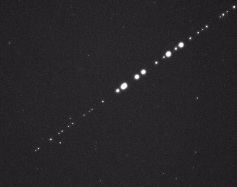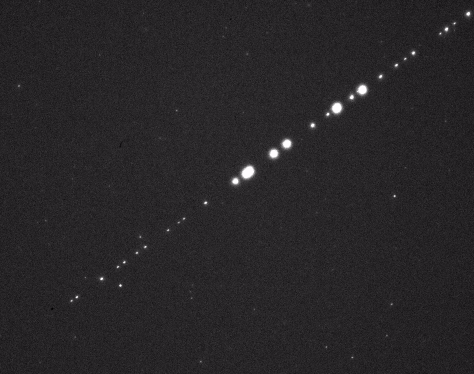We study the health of Starlink satellites Ilona Mask
 Stars in the sky shimmer beautifully ... But in reality - a steam locomotive of satellites launched yesterday by Ilon Mask, and for more than a day excitement the minds of lovers to look at the sky for the last 24 hours. Honestly, in reality, with my eyes, it looks very impressive ... A flying spear in the sky with a pole in the form of dozens of satellites and a spearhead on a sun glare. But are all satellites healthy? Upon closer examination of the recorded frames, it was possible to detect differences ... then under the cut some pictures and our video ...
Stars in the sky shimmer beautifully ... But in reality - a steam locomotive of satellites launched yesterday by Ilon Mask, and for more than a day excitement the minds of lovers to look at the sky for the last 24 hours. Honestly, in reality, with my eyes, it looks very impressive ... A flying spear in the sky with a pole in the form of dozens of satellites and a spearhead on a sun glare. But are all satellites healthy? Upon closer examination of the recorded frames, it was possible to detect differences ... then under the cut some pictures and our video ...Actually the news that you can see in our northern latitudes an epic picture of the passage of not two, three, not a dozen, but dozens of satellites at the same time, could not leave us indifferent and ... surprisingly lucky with the weather, after a week of continuous rains the sky clarified for exactly one hour, so that we had at least the opportunity to see them. Therefore, grandfather Zeiss got out of the suitcase and armed with the Neva400 camera.

And to leave with an attempt to see something on the outskirts of the city ... White nights did not bode that we could see something ...

But when the satellites appeared beyond the horizon, we realized that we could definitely record such bright satellites. The exposure was set to 40ms and this turned out to be a lot, it was possible to set 20ms, and even 10ms. The old laptop rustled merrily at the Winchester, but could not master the entire stream of beautiful four-megapixel frames, so there are gaps in the video stream.
Let's not torment, here is the actual video of the flight
The full video, without double clamping, is available at the link:
“ Starlink source video ”.
Upon closer examination, you will notice that not all satellites behave the same.
Firstly:
1. There are about 45 satellites in the main group of “total”,

2. Of these, there are several dual satellites located about 45-100 meters apart (the camera resolution was 45 meters in orbit)

3. And there is a whole bunch of satellites, not less than three, which “stuck together” as a bright spot. (one could assume that this is a step, but it should have too different ballistic coefficients, and it should have been far ahead or far behind the whole group)

4. Some satellites are very far behind the rest of the group, at least six:

And it would be possible to limit ourselves to this result if we were very unlucky and we did not catch a bunny from satellite batteries. The satellites are in a certain orbital orientation, and the camera could fix the glare of their batteries (and the satellites themselves) at a certain position relative to us and the Sun.

But not all ...
The satellites, which have lagged behind the group did not give a highlight, perhaps they are not oriented, and rotate, the lack of orientation may explain why they are slower slowing of the atmosphere.
Also, some of the satellites in the main group did not give a reflection.
And a group of “stuck together” satellites are also not in the same orientation as all other satellites.
It seems that at the moment only part of the launch passengers feels excellent - about 42-45, the rest are experiencing problems with orientation, or neighboring satellites are too close (within 50-100 meters).
Thanks to Ilon Mask, now many astronomy enthusiasts can regularly observe, view and discuss the behavior of its satellites. =))
Equipment used for shooting:
1. Camera Neva400 NPK Photonics
2. Lens Carl Zeiss 200mm F / 2.8
Point and date of shooting:
58.403965, 31.097421; 01: 16-1: 22 May 26, 2019 The
point of passage was determined by these TLE, the error is not more than a couple of degrees, you can use it to navigate the next couple of days, where to look:
STARLINK
1 70002U 19999A 19144.10416667 .00000000 00000-0 00000-0 0 09
2 70002 053.0000 175.8692 0001467 047.2921 324.9821 15.42070599 01 I
also wanted to thank Vera (and the entire NPK Photonika team) for the developed camera, Alexey, with whom we went to catch this beauty together which produced the processing of frames.
Good luck to everyone and clear sky.
PS: when using these materials - a link to the article is required.
